Ningpo
| Other Names: | Date of Sinking: c.1938 | ||
| Rig/Type: 3 masted Chinese Junk | Cause of Sinking: Beached and later burned | ||
| Length: 138' | Breadth: Unknown | Tons: 291 | Cargo: None |
| Built: 1753 | Location: Catalina Harbor | ||
| Hull Construction: Wood | Coordinates: See Catalina Harbor | ||
| Depth: 0-3' | Visibility: 3' | ||
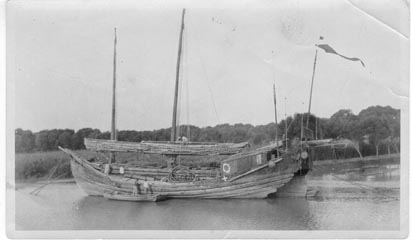
Laying under a few feet of water in Catalina Harbor is the wreck of the Ningpo. Built in 1753, the Ningpo spent 159 years in the Yellow Seas engaging in crimes such as smuggling, slave trading, mutiny, and piracy. While the number of people that have been killed aboard the vessel will never be known, it is said that 158 heads have rolled on the decks of the Ningpo.
The Ningpo was launched in 1753 in the city of Fu Chau as a 3-masted, 291 ton junk named the Kin Tai Foong. The 138 foot long junk was said to be the "fastest and best equipped vessel afloat in Chinese waters," and it wasn't long before the merchant trader turned into a smuggler and a slaver. Her first battle was during the rebellion against the Emperor in 1796 and according to Della Phillips' article, it was just the beginning of long series of events that would follow:
1806 Seized for smuggling and piracy
1814 Captured and set on fire at Nanking
1823 Seized for smuggling silk and opium
1834 Confiscated by the British under Lord Napier for smuggling and for carrying slave
girls to Canton
1841 Captured by the Chinese government and used for seven years as a prison ship for
pirates and smugglers. During this time, the Chinese government found some of the
prisoners too expensive to feed, and reportedly ordered 158 of them beheaded.
1861 Seized by rebels in Taiping and converted into a transport because of her size and
speed. Retaken by "Chinese" Gordon, in command of the English Imperial forces
against the Taiping rebel. Gordon changed her name to Ningpo meaning "calm
waves" or "peaceful waves" and after the city of the same name.
1861 Wrecked in a typhoon.
pre-1884 The vessel preyed on tourists in Hong Kong. Passengers were taken of board for a
few days' cruise. The unsuspecting passengers would then be robbed and set ashore. The
British vessel H.M.S. Calliope captured the Ningpo imprisoned the 60
crewmembers, and sold the vessel in Hong Kong.
1911 Captured by rebels in the battle of Hankow and sold to Americans for $50,000. 1912
Wrecked in a typhoon on June 12. Wrecked again in a typhoon September 26 off
Kyushi,
with the loss of the sails and use of the rudder. Crew mutinied and refused to work. Four
men rowed the vessel 320 miles back to port. Once in port, the crew were taken in arms. On
December 22 of the same year, a new crew sailed the repaired Ningpo7,000 miles in
55 days to San Pedro.
1913 Towed to Venice Beach for display. In April, the junk was towed down to San Diego,
and in October she was towed back to San Pedro. In November, the Ningpo wrecked off
Dead Man's Island. While being dry-docked and repaired in Long Beach, a small silver plate
was found behind one of the "eyes" of the ship. The plate had inscriptions on it
that were translated to say "The eye of the dragon is bright and colorful." Put
on display at Long Beach.
1915 Towed to San Diego and put on display.
Circa 1917 Towed to Catalina Harbor for display.
1938 Burned (possibly for a movie) in Catalina Harbor.
The Before her sinking, the Ningpo was one of the oldest vessels afloat, which brings about the question: How can a wood vessel remain afloat for so long? Nearly everything about the Ningpo's design and construction is unique to Western vessels. For instance, the vessel was designed to resemble a dragon. Her open bow (with her sides joined at the waterline, but widely spread apart at the deck level) was built to look like a mouth.
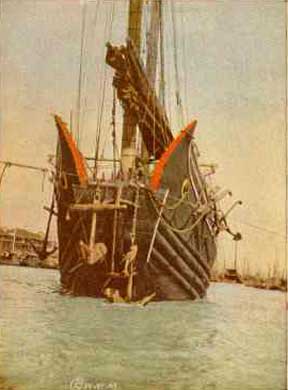
Bow of the Ningpo
The two disks on both bows formed the eyes, the masts and sails resembled fins, and her exaggerated high stern formed the tail of the beast. Two green sea serpents were portrayed on her sides near the stern, and lavishly colored Chinese artwork was carved on the transom of the ship. The Ningpo was constructed of Oriental woods rare to the West. Teak planks made up her deck, and ironwood--a wood so strong and dense that it doesn't even float (in fact, the ship's anchor was made of ironwood)--was used as planking for the vessel. This wood has a very high resistance to wood burying worms, and kept the ship afloat for nearly two centuries. A caulking made of fishing nets, tallow, and cocoa fiber sealed the hull planks. Every two and half feet, the planks are braced with camphor wood ribs. Foot long iron (and some bronze) spikes attached the planks to the ribs. To construct the ribs, "a tree of the right curve was selected, whip sawed in halves, and a half used on either side of the ship, thus preventing the slightest discrepancy in shape or symmetry." The fragrant aroma from the camphor ribs once filled the hull with a scent similar to nutmeg. The Ningpo's main mast was made of ironwood; 90 feet long, and nearly 3 feet in diameter, it was estimated to weigh 20 tons. At one time, the mast and its 5-ton boom flew silk sails. It sounds hard to believe that such heavy material would be used for a mast (making the vessel-top heavy), but when visitors were offered the chance to take a souvenir splinter from the mast, "their pocket knives would not even dent the hard surface." The Ningpo was constructed of so much wood that it prompted one seaman to comment that "there is sufficient wood in this old hulk to build six ships of modern construction." One very unique feature of the vessel's construction was the use of watertight bulkheads. The Ningpo had eight of these bulkheads, thus forming nine watertight compartments. There were no doors in the bulkheads, and each one of the compartments was accessible only from the deck. One of these compartments was dubbed the "chamber of horrors," A chi-lung (starvation cage) and "beheading swords" were kept in this compartment, as well as a long spear that supposedly was used to pick up heads from the deck. The giant 10-foot by 30-foot rudder was never mounted to stern. It was supported by two ropes attached to a windlass on the poop deck, and by two ropes that ran under the hull that were tied off at the bow. When anchored, the rudder would be raised out of the water by use of the special windlass on the poop deck, The rudder could be steered by one or up to 12 men by use of two tillers. Bamboo cable--said to be stronger than' steel cable--was, used onboard the ship.
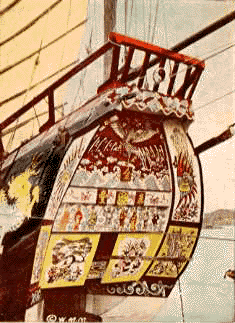
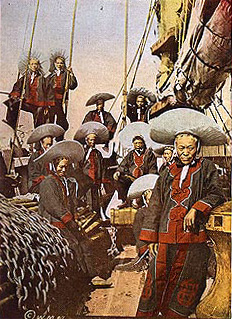
Left: The stern of the Ningpo. Right: The "crew" of
the Ningpo.
Forward of the main, two 3' long swivel guns were mounted. These small guns were used an numerous occasions, the last being in l911. In 1917, these guns were estimated to be 400 years old. A unique Chinese invention, the capstan, made of mahogany was used to raise the large ironwood anchor. Another capstan, made of iron was used to hoist sails.
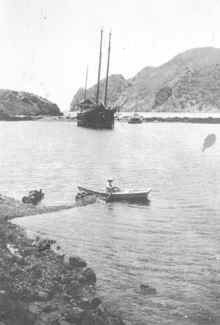
The Ningpo in 1918. Note the boatman waiting to take tourists to the beached junk |
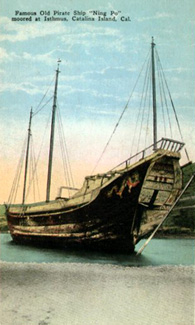
A stern view of the Ningpo beached. |
'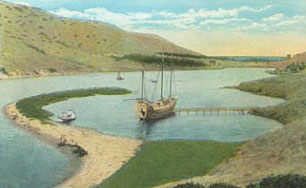
The wreck of the Ningpo lays in the place she was beached back in 1918. |
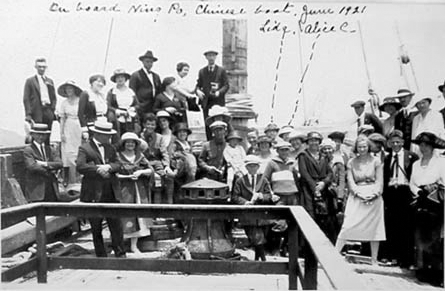
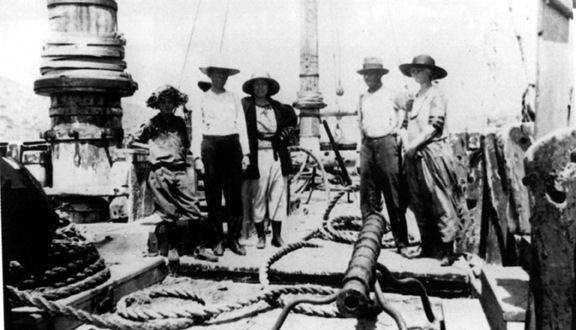
Tourists inspect the Ningpo.
During the 20's and 30's the Ningpo sat at anchor in Catalina Harbor with other derelict vessels such as the Palmyra, the Charles F. Crocker, and the Margaret C.. On occasion, she was used as a backdrop for movies filmed at the Isthmus. After a few years, the neglected ship partially filled with water and came to rest on a mudbank near Ballast Point. Summer caretakers charged admission to board the ship up until 1927. In 1935 a fire burned the vessel down to the waterline. For many years, Boy Scouts and local residents would use the wreck as a quarry for rare woods. Since then, the forgotten wreck has slowly settled below the surface and into the soft bottom of the harbor.
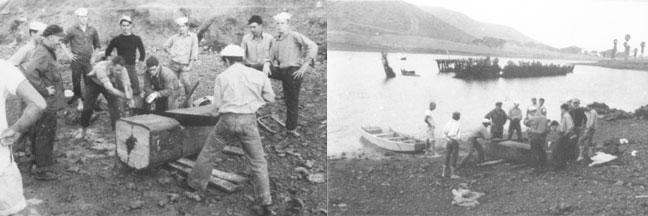
The Explorer Sea Scouts recovered the stump of the Ningpo's mast back in 1952
during an extreme low tide. The mast was then sawed up and distributed to Boy Scouts
attending the Boy Scout Jamboree the following year. Note that the mast was made of
ligma vitae, and extremely dense wood that does not float.
Many of the artifacts aboard the Ningpo were said to be of "dubious authenticity. " No one knows how many original artifacts were taken from the ship, or how many fake items were added in order to promote ticket sales.. For instance, the existence of the famous "chopping block" (where prisoners were supposedly beheaded) is doubtful, because the Chinese never used blocks for beheadings
.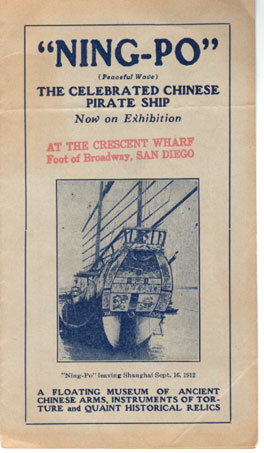
A promotional brochure containing stories--many of which are questionable--about the Ningpo.
At any rate, authentic or fake, some the items once aboard the Ningpo, (as well as some of the woodcarvings made of the timbers of the ship) can still be seen on display in the Catalina Island Museum in the Avalon Casino.
Sources: Don H. Kennedy, "The Infamous Ningpo," American Neptune, 10(1969), p262-73; Della Phillips, "A Peaceful Pirate," Overland Monthly, 19 (1917), 327-31.; Anna Marie and Everett G. Hager, "The Ning Po, A Fabled Chinese Junk in Southern California Waters," BrandBook, 15 (1978)1 193-03; H. K. Raymenton, "The Venerable Ning Po" San Diego Historical Quarterly, Spring (1958), pp. 50-54.
For more information, see Catalina Harbor
| Like to learn more about this wreck? Visit our Guest Page to submit your inquiry. |
